Exhibition
Personal exhibition of Alexander Shishkin-Hokusai

Category
ExhibitionDate
02 june 2021, 11:00 — 30 july 2021, 19:00
Price
Free of charge
Events / Exhibition
A personal exhibition of Alexander Shishkin-Hokusai, an artist participating in the Russian pavilion at the Venice Biennale in 2019, opens at the Marina Gisich Gallery!
Alexander is a St. Petersburg artist and set designer, multiple laureate of the Golden Mask theater prize, one of the exhibitors of the Russian pavilion at the Venice Biennale in 2019. Works as a production designer in a theater, as well as painting, installation and performance. Permanent co-author of directors Andrei Moguchy and Yuri Butusov.
Shishkin-Hokusai divides his work in the theater and in contemporary art, performing in the field of the latter under the pseudonym “Hokusai”: “Shishkin worked with nature. But to it I added the antagonist Shishkin-Hokusai. Hokusai with characters, with figurative plastic, acting in a sense. Thus, I encrypt two vectors for myself: Shishkin as an environment moment, and Hokusai as psychodrama, working with homo sapiens, ”the artist explains.
His works are characterized by absurdity and surrealism, a discrepancy between the external and the internal. The artist explains this interest by his theatrical roots, because for him the theater as a whole is the embodiment of the absurd.
From June 2 to the end of July, the exhibition Riva degli Schiavi ("Slave Quay") is being held at both sites of the Marina Gisich Gallery. Alexander Shishkin-Hokusai defines the mood of his new exhibition as “life after death”. Returning to the project for the Russia Pavilion at the Venice Biennale after a long break, burdened by quarantine, the artist seeks to see and relive the complex kinetics of an installation dedicated to the Hermitage. The Venetian work at Riva degli Schiavi (Slave Quay) will be supplemented and rethought with a series of new pieces based on the study of the iconography of glossy publications and model faces outside Europe. Blue, a color that came to the European part of the world from India, Iran and Afghanistan, plays a key role here.
In the new series, Shishkin-Hokusai experiments with the attributes of slavery (ropes, chains) and introduces the idea of art as a "living machine" capable of suffering and changing from the views and touches of the audience.